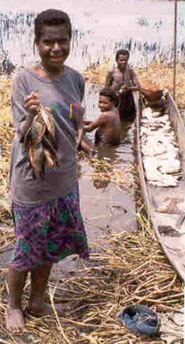 |
|
| |
What can be done |
| |
FAO has pledged to help its member countries achieve three overarching
global goals:
 PNG. Introduced tilapias can be important to local fisheries. Photo by U.Kolkolo
PNG. Introduced tilapias can be important to local fisheries. Photo by U.Kolkolo
- access of all people at all times to sufficient, nutritionally
adequate safe food;
- continued contribution of sustainable agriculture and rural
development to economic and social progress and well-being; and
- the conservation, improvement and sustainable use of natural
resources for food and agriculture.
The responsible use and control of alien species will help to
achieve these goals. Specifically, FAO can assist with:
- developing national and regional policies regulating the introduction
of species;
- assembling groups of experts from many disciplines to address
technical, political, social and economic issues;
- assembling information sources such as DIAS;
- helping to implement the Code of Conduct for Responsible Fisheries
and the ICES Code of Practice on the Introduction
and Transfer of Marine Organisms;�
- raising awareness of risks and benefits associated with the
use of alien species through web sites, publications and other
media.
This assistance can be requested through FAO's Regular Programme,
FAO's Technical Cooperation Programme, FAO Regional Representations
and the FishCode Programme of Global Partnerships for Responsible
Fisheries.
WHAT CAN YOU DO?
 Fisheries Monitoring in Mekong River Basin, Cambodia. Decisions
to introduce alien species have far reaching social, economic and
ecological implications and should be based on careful assessments
of long-term benefits and risks.
Fisheries Monitoring in Mekong River Basin, Cambodia. Decisions
to introduce alien species have far reaching social, economic and
ecological implications and should be based on careful assessments
of long-term benefits and risks.
Through application of the framework
proposed in this CD-ROM objective science-based assessments of benefits
and risks can be achieved and responsible decisions regarding alien
species can be made.
- Balance benefits of an introduction against the risks. Accurate
information on the species, its history of impacts when introduced,
and how and where it will be used will be crucial for informed
decisions. The ICES Code of Practice on the
Introduction and Transfer of Marine Organisms provides a mechanism
for gathering and evaluating such information.
- Investigate available information. To facilitate decisions on
the introduction of alien species, FAO offers through the Database on Introductions of Aquatic Species (DIAS)
information needed for a first risk benefit analysis. DIAS contains
information on experiences of species introductions and their
socio-economic and ecological impacts.
- Monitor and report
actions and experiences. Data on the introduction process
and its effects should be collected and made available to the
international community, so that lessons can be learned from positive
or negative experiences. FAO's DIAS gives the possibility to share
experiences with the international community and represents a
point of reference for considered introductions in the future.
- Raise awareness and increase the involvement of the general
public and the industry. Many bad introductions are made out of
simple ignorance. The aquaculture industry should be particularly
concerned as many of the most severe economic impacts have happened
to aquaculture.
|
 Introduced
species in fisheries and aquaculture
Introduced
species in fisheries and aquaculture
 Fisheries Monitoring in Mekong River Basin, Cambodia. Decisions
to introduce alien species have far reaching social, economic and
ecological implications and should be based on careful assessments
of long-term benefits and risks.
Fisheries Monitoring in Mekong River Basin, Cambodia. Decisions
to introduce alien species have far reaching social, economic and
ecological implications and should be based on careful assessments
of long-term benefits and risks. PNG. Introduced tilapias can be important to local fisheries. Photo by U.Kolkolo
PNG. Introduced tilapias can be important to local fisheries. Photo by U.Kolkolo